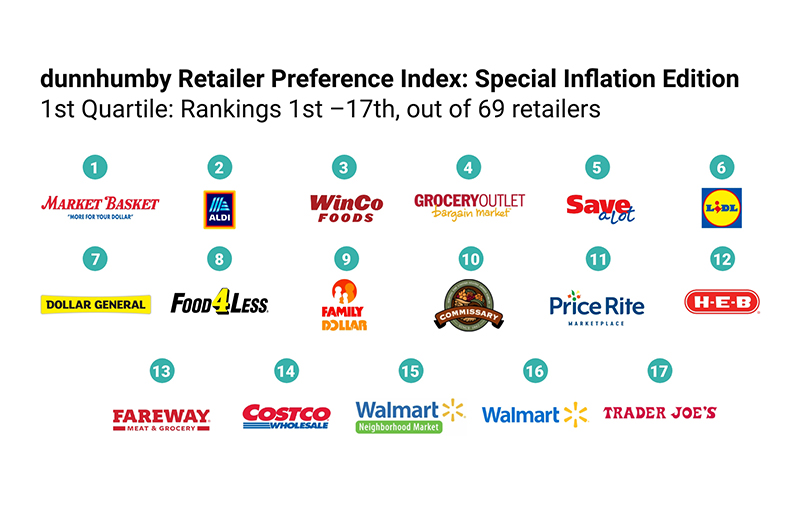Dunnhumby released a special edition of its Retailer Preference Index, a nationwide study of the $1 trillion U.S. grocery market, examining which grocers are winning customers as the economy falters. The edition was released Sept. 19-22 as dunnhumby attends the Groceryshop expo at Mandalay Bay Resort in Las Vegas.
Market Basket bested Aldi and third-placed Winco as the top-ranked grocer during inflationary times. Grocery Outlet and Save A Lot rounded out the top five due to their ability to save customers money at a time when this matters more. The next five retailers in the top 10 are Lidl, Dollar General, Food4LessFoodsCo, Family Dollar and Military Commissaries.
The dunnhumby RPI: Special Inflation Edition was released as part of The dunnhumby Quarterly: a strategic market analysis of key retail themes, with the latest edition focused on consumers’ reaction to rising grocery prices.
While Amazon is better positioned than any retailer for long-term success in grocery, its value proposition for inflationary times is no better than the average grocer. As a result, Amazon dropped out of the first quartile as its web traffic declined 6.5 percent so far this year. H-E-B, the top-ranked e-commerce retailer in the dunnhumby e-commerce RPI, finished 12th.
Key findings from the study:
- Market Basket topped all 69 retailers in the Inflation RPI rankings, ahead of discounter names like Aldi, Dollar General and Walmart, by ranking first in the U.S. in the “save me money” pillar. Market Basket is the only retailer in the U.S. who is in the top-five in both base price perception and mass promotions perceptions. Aldi, meanwhile, is just in the top-five in base price perception.
- The “save me money” customer driver is five times more important than the next-most important drivers, “save me time” and “make it better.” However, for driving long-term results, saving customers’ money is only one and a half times more important than delivering high quality.
- Retailers can minimize the damage and strengthen emotional bonds with customers by keeping base price gaps close while using best practices in orchestrating execution of mass promotions, communications, personalization and private brand. Kroger, Food Lion, BJs Wholesale and ShopRite are examples of retailers who have customer value propositions that stand up best to base price leaders during inflationary times.
- Inflationary times are a big headwind for a specialty retailer (such as Sprouts, Wegmans and The Fresh Market) and for regional grocers with a quality-first position (i.e., Publix and Harris Teeter). These retailers are not well positioned for inflationary times since they are too far behind most of the market in “save me money” perceptions. These retailers are also behind the market in year-over-year visit growth.
- Inflationary times are a big tailwind for discounters, such as Dollar General, Family Dollar, Grocery Outlet, Lidl and Save-a-Lot. During periods of economic stability, these stores have a highly vulnerable proposition for the long term due to quality weaknesses. They are also vulnerable due to much higher cross-shop with each other and other inflation-ready retailers.
- Inflationary winds have also taken some of the wind out of club channel sales. Club channel retailers are underperforming the market in year-over-year visit growth. The current club channel difficulties reflect misalignment with shoppers’ behavior shifting toward spreading their spending out over more visits with smaller baskets. Additionally, lower income shoppers are more likely to shift toward smaller pack sizes during inflationary times.
The overall RPI rankings are the result of a consumer survey-informed statistical model that predicts how retailers execute on the customer needs that matter most for driving performance and emotional bonds with shoppers. As part of this study, two online surveys, one in October 2021 and a second survey in May-June, were conducted surveying 18,000 grocery shoppers.

